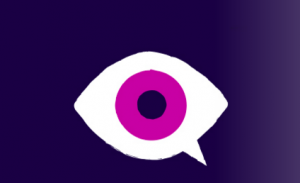I was really inspired by the “love has no labels” campaign that we discussed in class, so I went to the Ad Council website to see what other campaigns they have done. Although I came across many that I liked, my favourite was the “I am a witness” campaign. Their main objective was “to stop bullying by activating the silent majority of kids who witness it each day transform them from passive bystanders into a united, empowered and active collective that will speak up against bullying”.
At the heart of the “I am a witness” campaign was a Witness Emoji, which was available for free download on the Apple App Store. The Witness Emoji was shaped like a speech bubble, but the app provided teens with multiple stickers to choose from. The incentive was for teens to post the emoji when they saw a hurtful comment online, or send one to a friend as a form of support. I think this app is brilliant, because as we know, social media is plays a pivotal role in society (especially for teens).
I think with the right tools and resources pro-social marketing can be really powerful. I think it’s the ad campaigns like “love has no labels” and “I am a witness” that create awareness and influence consumers to make changes in their behavior. I think it’s all about starting that conversation – and who knows how to do that best? Marketers!
There’s a misconception that marketing is only for promoting products and their attributes. I think sustainability marketing goes much further than that – it is focused on changing consumer lifestyles. It shares a very close relationship with pro-social marketing, which isn’t about marketing product attributes to generate sales, it’s about influencing behaviour change. There are consumers who still drink a can of soda and throw it away in the garbage (hard to believe – I know). Consumer lifestyles are extremely difficult to change. Marketing has an opportunity to influence the way people consume, reuse, and dispose products in their day-to-day lives. Sustainability marketing initiatives share similar objectives to those of health campaigns. For example, a health campaign targeting nicotine smokers is trying to create an incentive for users to quit. This is essentially no different from the campaigns that try to incentivize consumers to recycle.


Hi Braelyn, I really liked this post you made. I too agree sustainable marketing goes further than just the promotion of products – at its heart it is a promotion of behavior. Regardless of whether the behavior pertains to the health of our planet, or the social wellness of our youth, all sustainable initiatives share the goal of improving our future. Marketing can be such a fine art, because it’s hard to tell people to do things. I think it’s quite interesting that by using video and demonstration, as in the “love has no labels” campaign, as opposed to direct wording like “don’t discriminate,” we feel encouraged to promote like messages. And, by simplifying instructions, through visual marketing, as in the “I am a witness” campaign, we are better able to connect with a young demographic to share our messages. It seems marketers have to continually adapt to new technologies as well, to keep up with trends, in order to best advertise their causes and connect with audiences. Thanks for your insight!
What struck me the most about this campaign is the use of emjois and social media in their effort to eliminate passive bystanders. It’s clever to me because they decided to use the exact same channel of communication through which much of the bullying by today’s youth travels. I think this applies to any marketing initiative. If you put the solution right next to the problem, and allow it to easily spread through your target market via the same methods, you will see results.